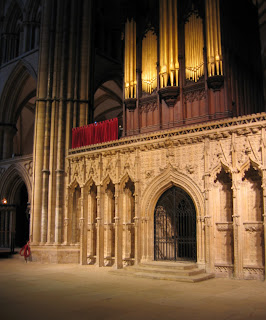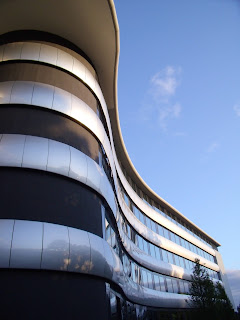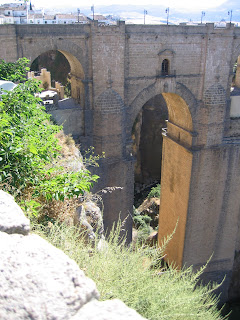My first visit to Lincoln Cathedral was some years ago in the middle of winter. I was on a work training course. One afternoon I said to the class that I intended to go to hear Evensong that day. To my surprise all eight of us ended up packing into taxis right after the end of the training session and thereby doubling the congregation for the service.
This was at a stormy time in the church affairs of the Cathedral. Various of its clergy had entered into bitter internecine warfare with one another. They indulged in religious politics with a small 'p' and it was reported in the national newspapers with lipsmacking relish. The reputation of the CofE was once again being damaged.
We padded into the darkened church and sat in one part of the choir stalls while the choir sang across the aisle to one another. This is a service of which nothing obvious is required of the visitor. You passively allow the ceremonial to pass before your eyes and to enter your ears.
The Presentor, dressed in his black robe and holding a staff, walked slowly backwards before the Cannon as he approached the lectern to give the reading of the day. They acknowledged one another with a bow of the head and the bedecked Cannon climbed two steps to the brass eagle lectern, its wings spread out to support the huge Bible. That eagle is the symbol of the Evangelist St John. The day's reading was a long, long way from John's message of hope.
In severe contrast we listened to a reading from Leviticus, to the story of Moses slaughtering rams, making burnt offering and gathering up the blood to use it as follows: The First ram had its Blood poured out around about and Upon the Altar. The 2nd Ram had the Blood applied to Aaron’s right ear, thumb, toe. Then blood was applied to Aaron' sons as well. A messy business and brutal.
The Cannon rolled on in his pinched Received Pronunciation and rather prissy delivery, I did wonder how, step by step, we have evolved from that atavistic rather brutal faith where priests would be up to their elbows in warm blood, to the now vitiated, staid ceremonial of embroidered vestments and incense that we were observing.
Mind you, there was plenty of emotional bloodletting going on behind the scenes where reputations were being slaughtered instead of animals. Possibly not much more civilised after all.
In severe contrast we listened to a reading from Leviticus, to the story of Moses slaughtering rams, making burnt offering and gathering up the blood to use it as follows: The First ram had its Blood poured out around about and Upon the Altar. The 2nd Ram had the Blood applied to Aaron’s right ear, thumb, toe. Then blood was applied to Aaron' sons as well. A messy business and brutal.
The Cannon rolled on in his pinched Received Pronunciation and rather prissy delivery, I did wonder how, step by step, we have evolved from that atavistic rather brutal faith where priests would be up to their elbows in warm blood, to the now vitiated, staid ceremonial of embroidered vestments and incense that we were observing.
Mind you, there was plenty of emotional bloodletting going on behind the scenes where reputations were being slaughtered instead of animals. Possibly not much more civilised after all.
But here, in this vast, famous, ancient church they could only summon up about 15 or so celebrants, half of whom were basically tourists. No doubt there would be queueing if the blood was to flow publically. For me, the service was aesthetically attractive, but spiritually suffocated and dead.
On another visit to the Cathedral, many years later, Jane and I took the tour of the roof spaces. It was terrific to spy the church from such different vantage points, both its main interior space and the outside, where we were high up with close views of the towers and could see miles over the plane below the Cathedral hill. The most impressive aspects though were to walk through the interior roof spaces where traces of the construction methods were evident. It felt like walking through a vast timber ship. Many of those original timbers from 900 years ago remained in good condition. It has as its website says, been shaken by earthquakes and struck by lightening; but it stands almost in spite of nature and the conflicts of men.
































































